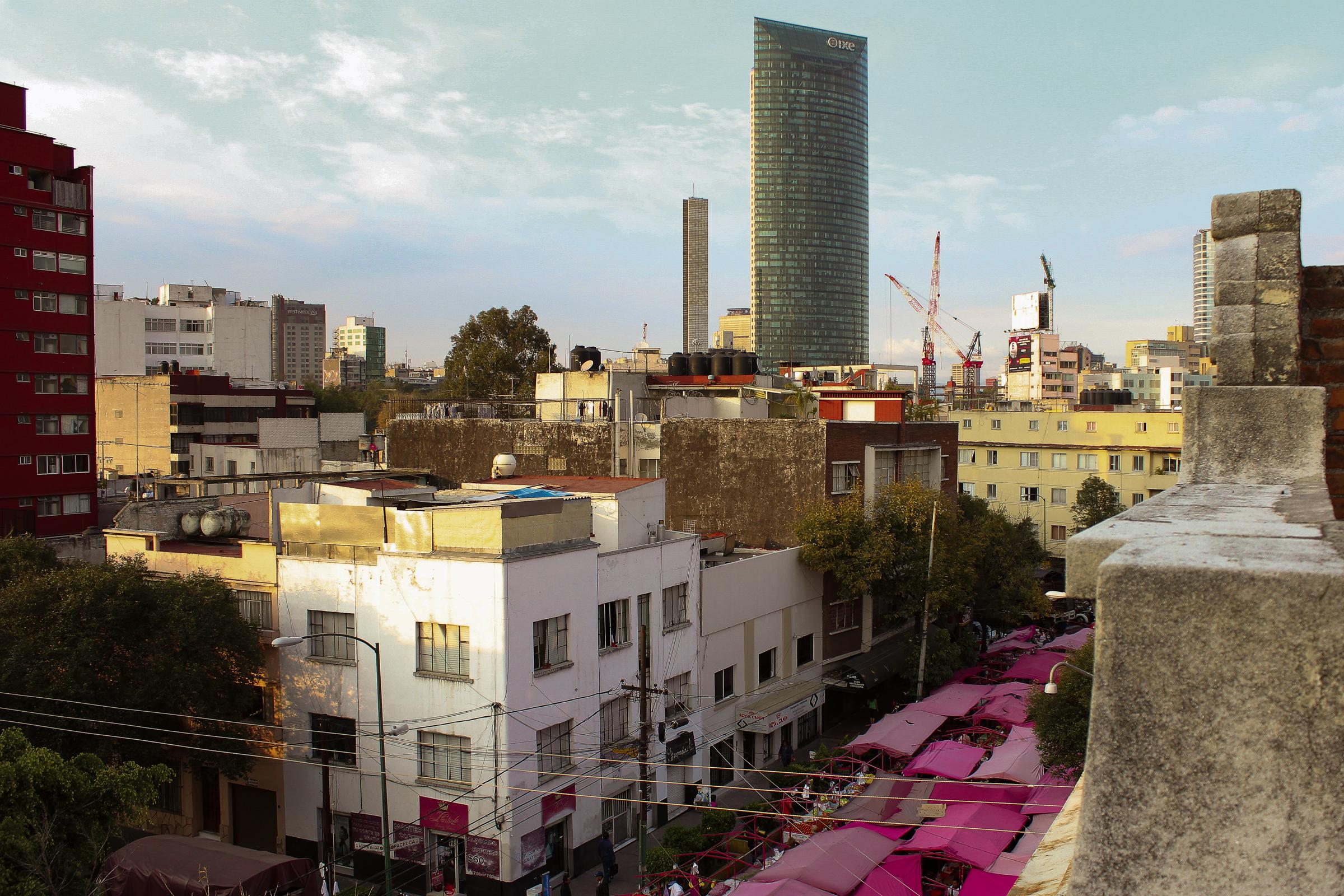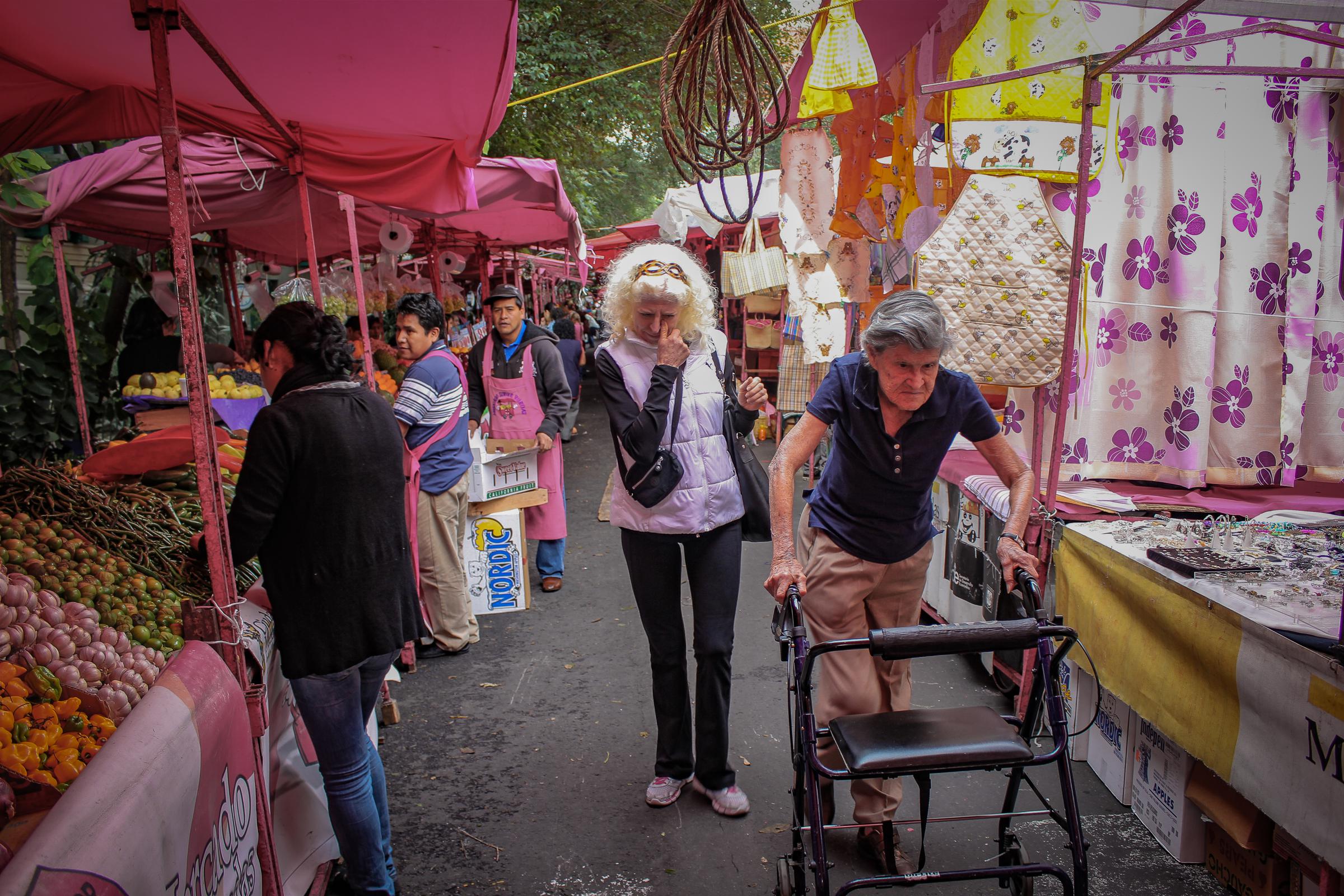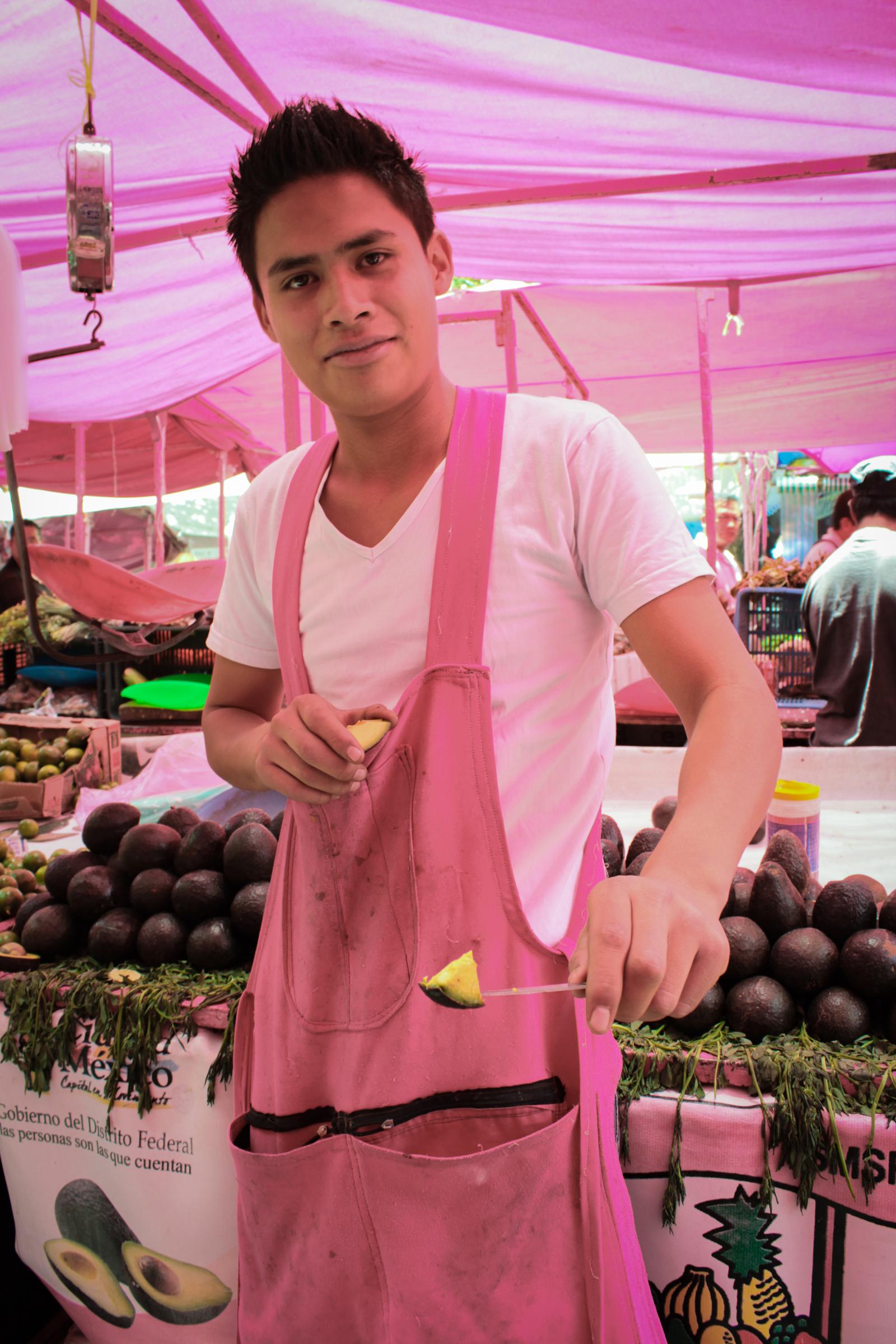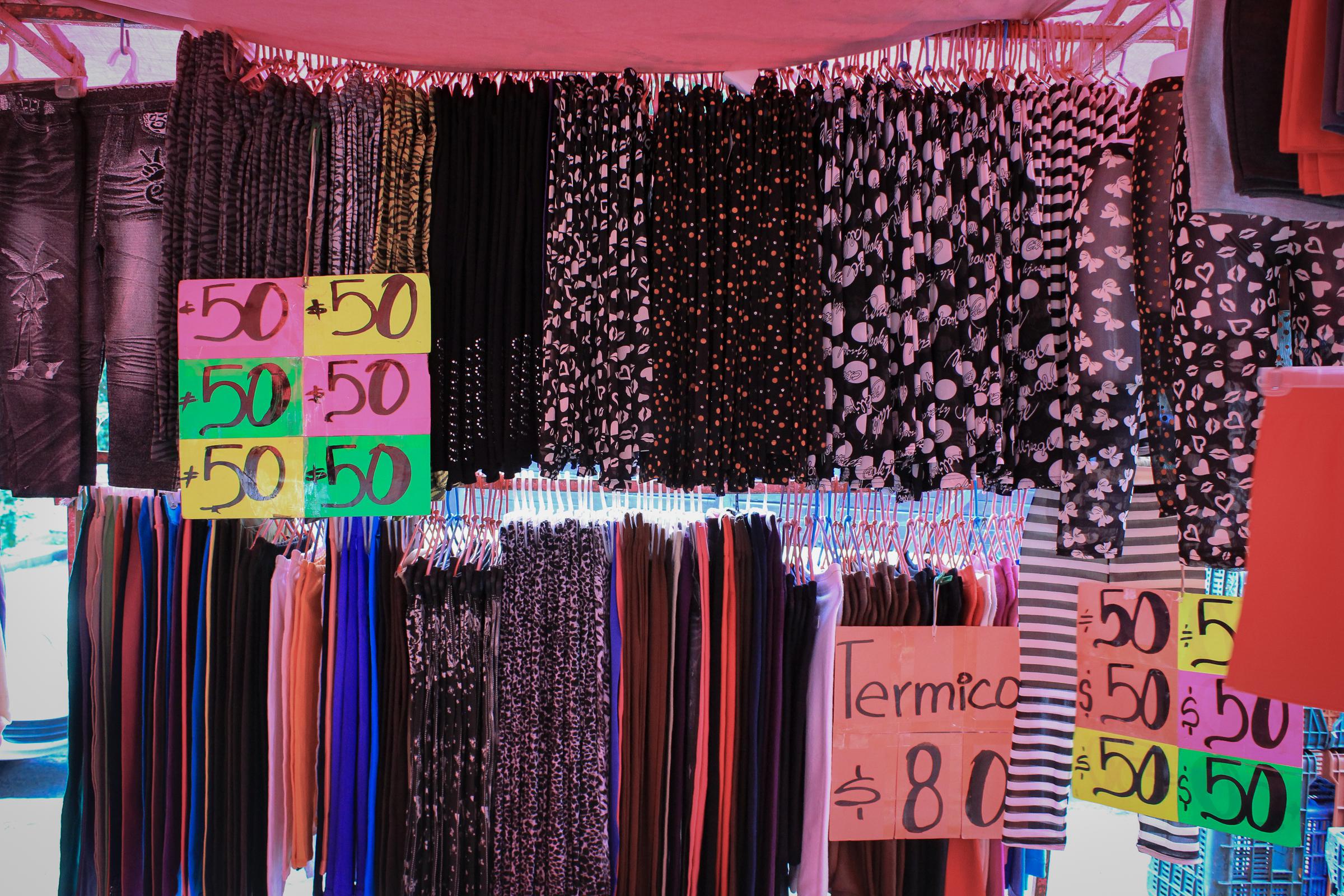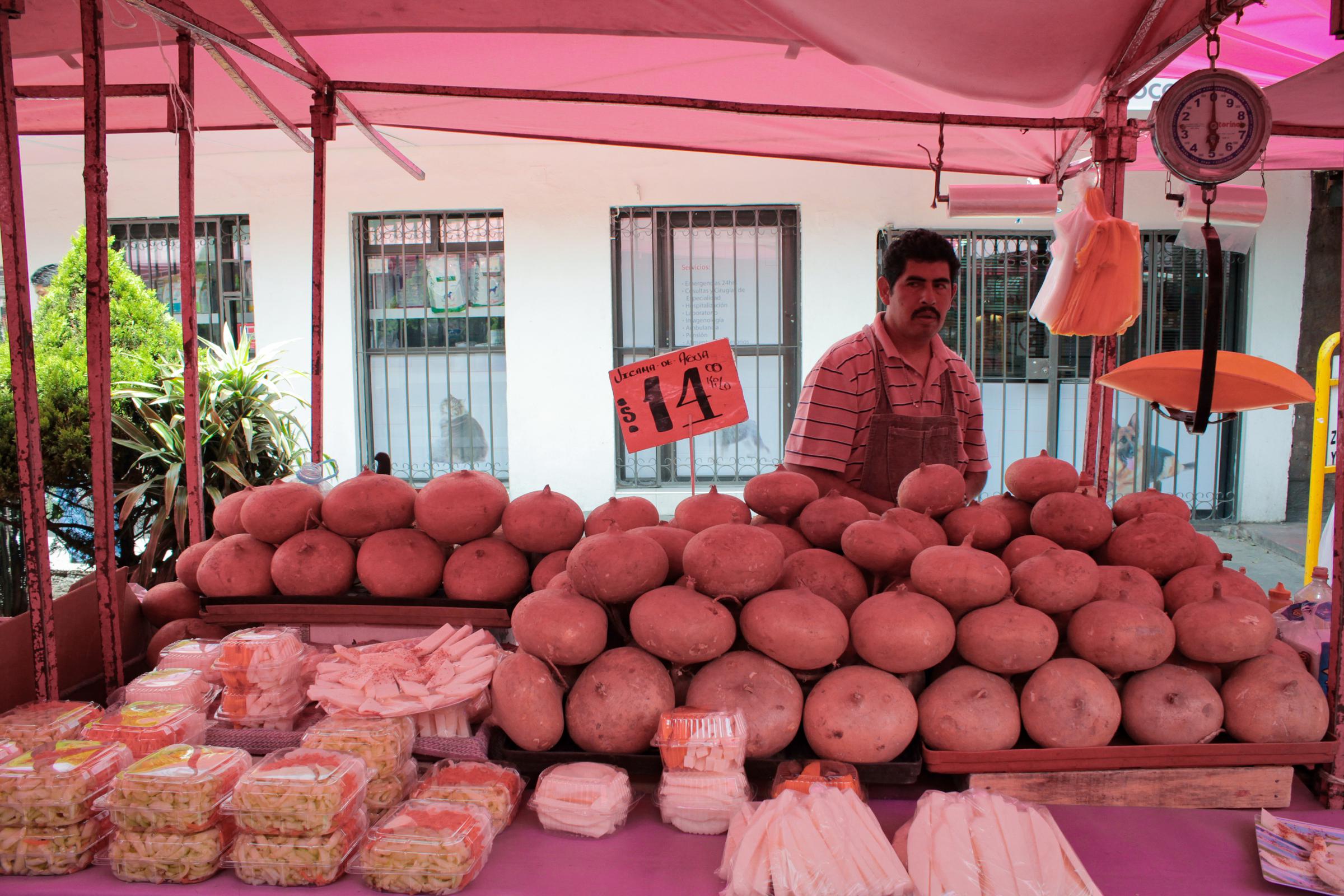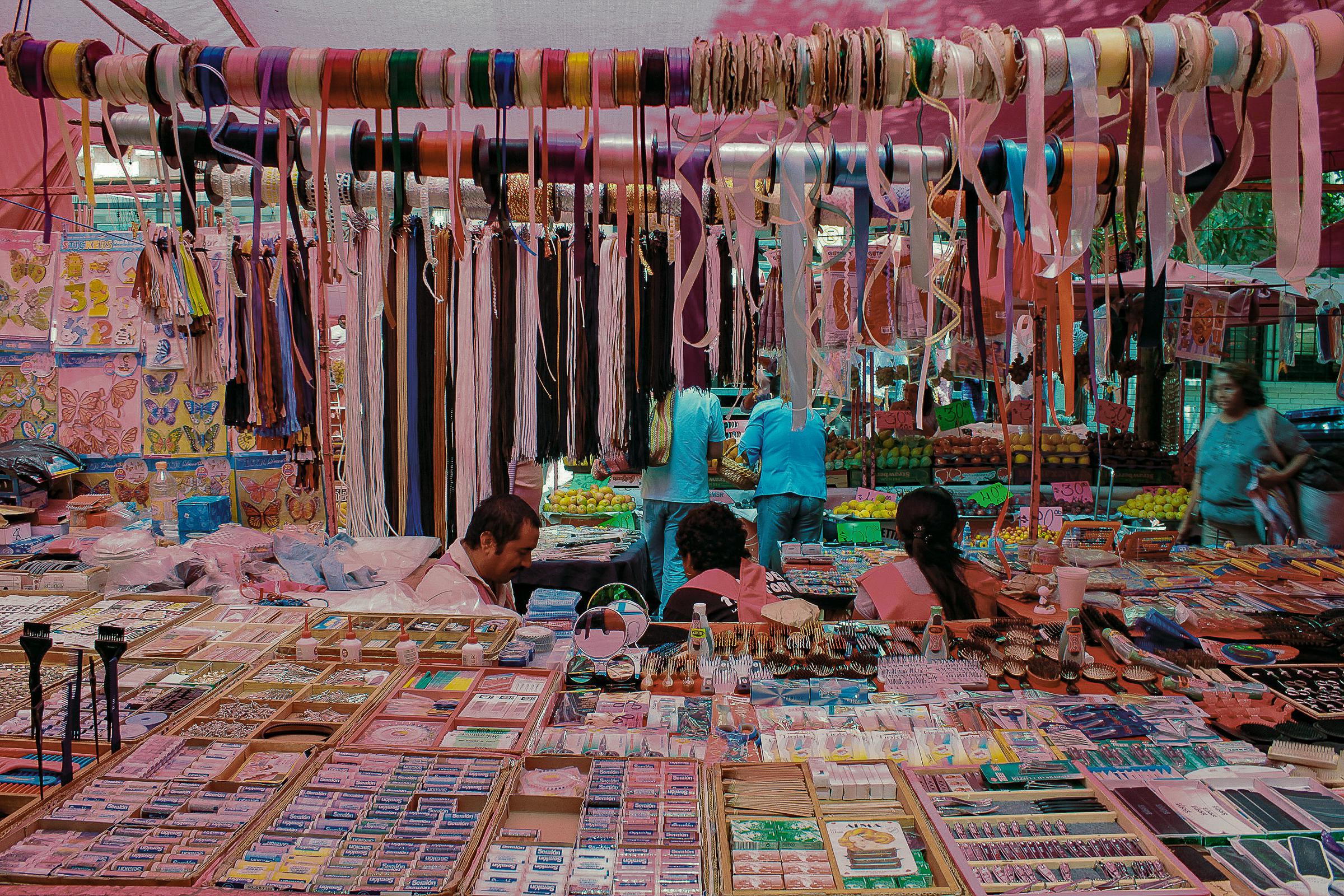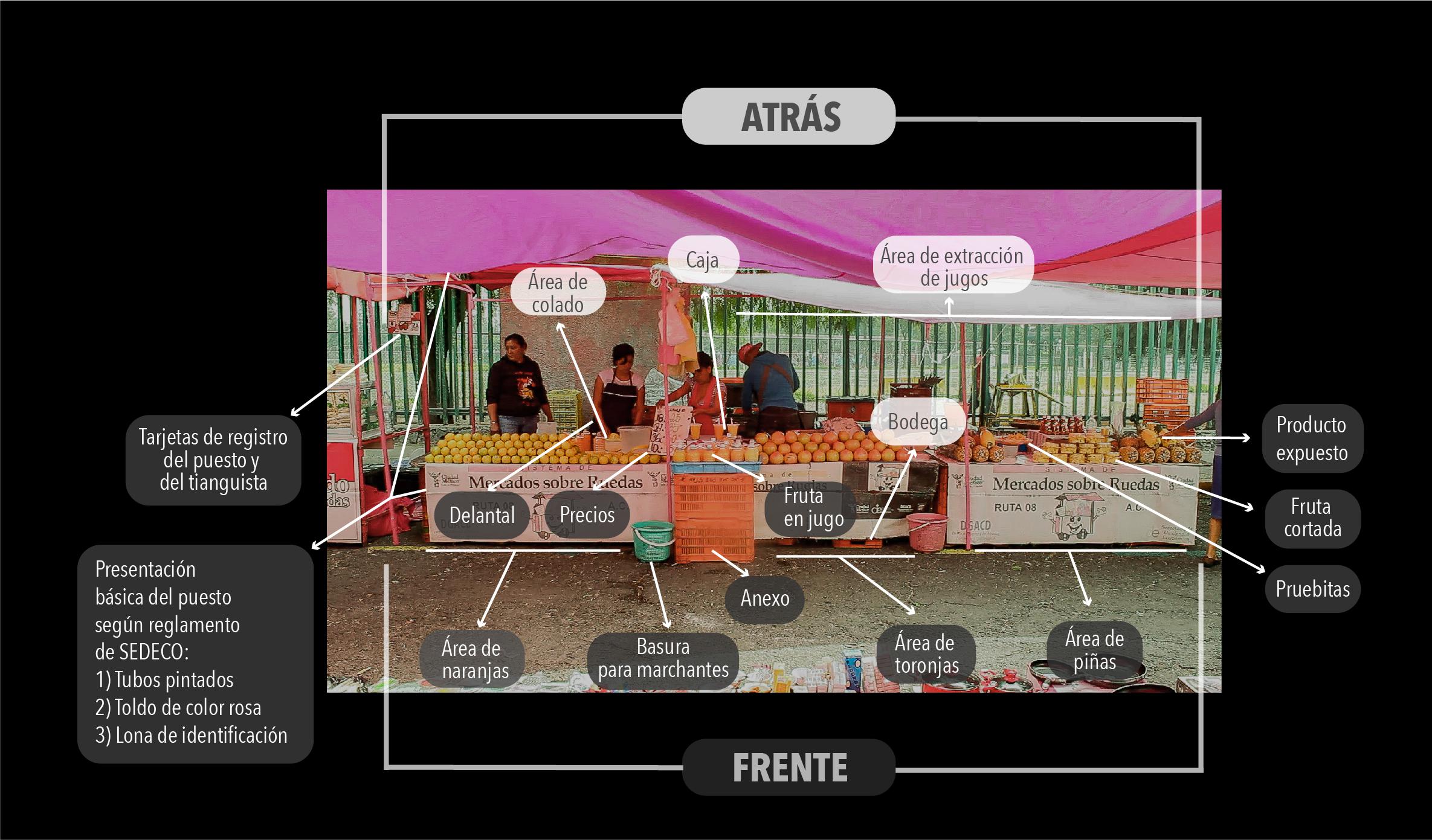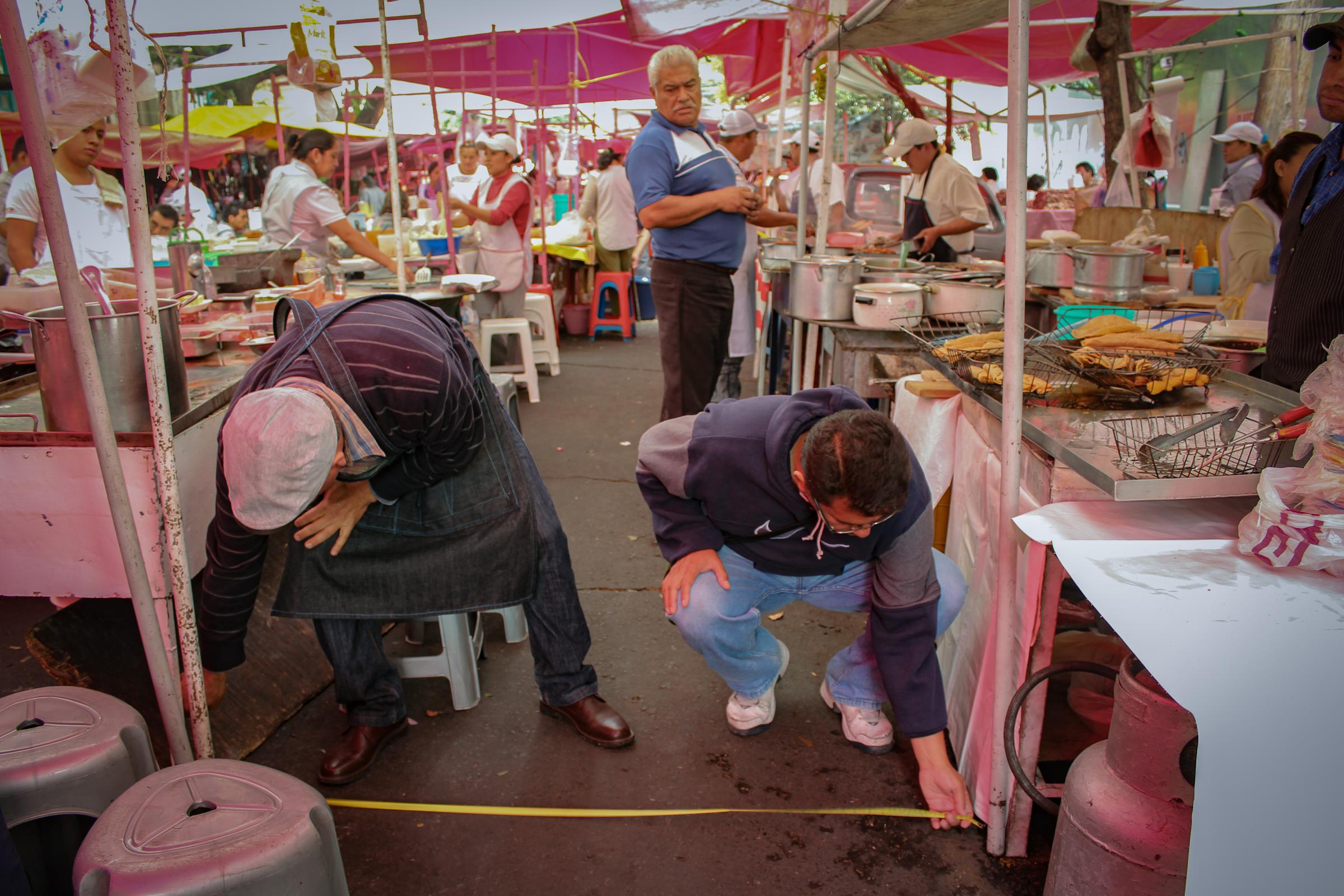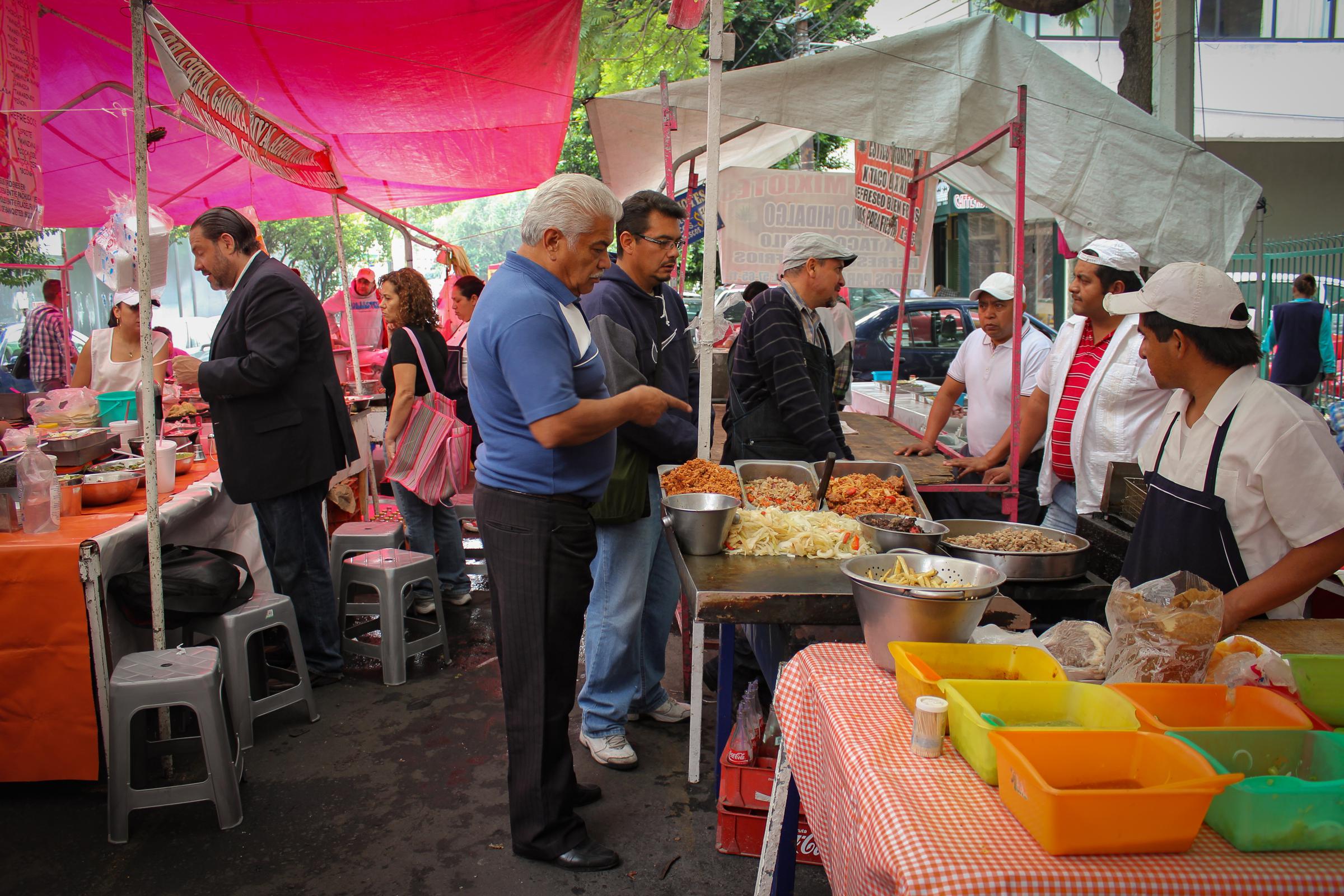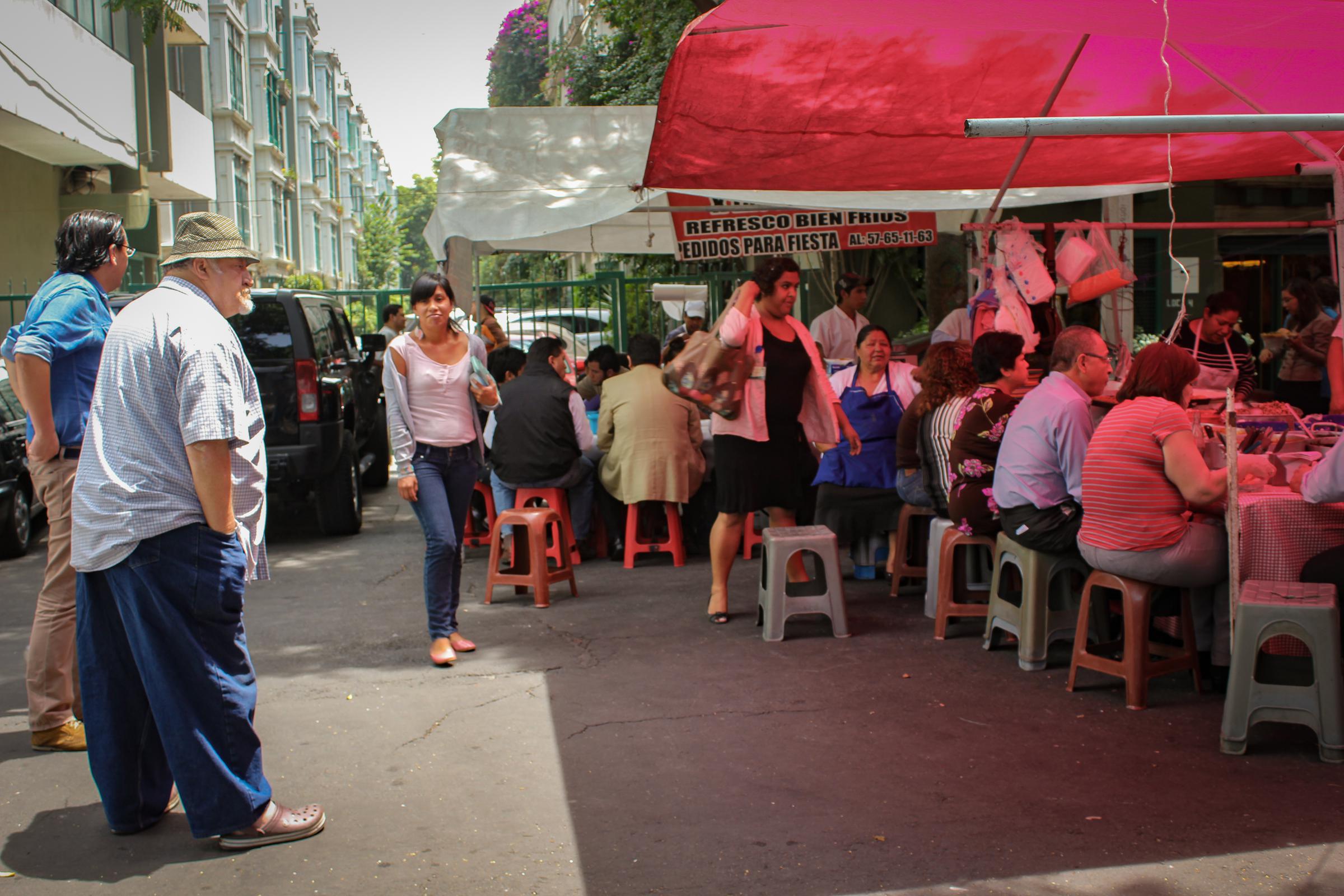The awareness of being looked at: giving a view of the tianguis stall
- Frances Paola Garnica Quiñones
- ― see biodata
The awareness of being looked at: giving a view of the tianguis stall
Receipt: July 5, 2023
Acceptance: October 13, 2022
Abstract
This photo essay shows the process of give viewThe study also shows the importance of the stall's materiality and visuality in terms of its aesthetic production and the affectivities and values associated with it, which result in a visual language of the market. The importance of the materiality and visuality of the stall is exposed in terms of its aesthetic production and the affectivities and values that are associated with it and that result in a visual language of the market. This essay derives from the ethnographic work carried out between 2012 and 2013 in collaboration with Ruta 8, one of the associations of merchants enrolled in the Mercado Sobre Ruedas program (msr), coordinated by the Secretariat of Economic Development (sedeco) of Mexico City (cdmx).
Keywords: street vending, visual comunication, work culture, material culture, esthetic, tianguis
THE CONSCIOUSNESS OF BEING LOOKED AT: GIVING SIGHT AT THE OUTDOOR MARKET STALL
This photographic essay shows the process of give viewa stall presentation practice composed of certain aesthetic elements that allows a crucial communication flow with other market actors to assure its continuity. This shows the importance of the materiality and visuality of the stall both in its aesthetic production and the affectivities and values associated with it and that result in a visual market language. This essay is derived from the ethnographic work carried out in 2012 and 2013 in collaboration with Ruta 8, one of the associations of merchants registered in the Market on Wheels program coordinated by Mexico City's Secretariat of Economic Development.
Keywords: street vending, outdoor market, material culture, visual dialectic, aesthetics, labor culture.

Introduction
The tianguis stand is a daily occurrence in Mexico City (cdmx). Once a week, residents of multiple neighborhoods encounter a row of colorful awnings set up along a street. These are the tianguis or street markets, whose flow and crossing of different people and objects generates a space of possibilities for subsistence, sociability, exploration and recreation.
Moving between Agrícola Oriental, Satélite, Velódromo, San Rafael, Iztapalapa, Santa Fe, Roma and Nápoles, the Ruta 8 merchants' association sets up shop from approximately five in the morning until five in the afternoon during the week. Ruta 8 belongs to a network of ten street markets regulated by the Secretary of Economic Development of the City of Mexico City. cdmx (sedeco) through the Mercados Sobre Ruedas program (msr). These street markets are classified as "rutas" because each has been assigned to a particular circuit of neighborhoods in which to set up stalls. Each route is administered by civil associations of tianguistas.
Route 8 attracts housewives, office workers, tourists, cab drivers, homeless people, young people, children, senior citizens, religious people and street vendors, whether for shopping, entertainment, socializing or offering products and services, such as cabs, taking advantage of the influx of people generated by the tianguis (the market).images 1 and 2).
Academic attention to tianguis has generally focused on political-economic analysis, particularly from the dichotomy of formal/informal economy, social networks and consumption studies (see Hart, 1985; Cross, 1998; Zinkhan, 1998). et al1999; Silva, 2007; Crossa, 2009; Bhowmik, 2010). This is explainable given that street commerce has been and continues to be an alternative solution to face the high rates of unemployment resulting from globalization processes, the proliferation of the tertiary sector and the precariousness of the labor market (Aguilar, 1997; Gayosso, 2008; Mete et al., 2013). However, little research has approached tianguis from the everyday practices that compose it (see Alba et al2007; Duhau and Giglia, 2009; León, 2010; Sandoval, 2020). I am interested in contributing to this last approach, as I believe that the tianguis is a phenomenon that transcends the mere exchange of goods; in my opinion it is much more than a part of the chain of production, commercialization and consumption of goods.
Several authors have criticized the theoretical approach of consumption studies. For example, Graeber (2011) argued that such a broad definition of the concept of consumption leads to the assumption that all human activity is immersed in the production-consumption dynamic:
[...] "consumption" has come to mean "any activity that involves the purchase, use, or enjoyment of any manufactured or agricultural product for any purpose other than the production or exchange of new products. For most wage earners this means almost anything one does when one is not working for wages" (Graeber, 2011: 491 [translation mine]).
Because of this broad definition, some anthropologists have turned to argue that consumption has been falsely portrayed as passive acquisition, when it is more commonly an important form of expression. From this, it has been assumed that there are diverse meanings to acts of production and acquisition of goods that contribute to the creation of values, identities, and even subcultures. But, perhaps, Graeber tells us, "the real question should be why the fact that manufactured goods are involved in a human activity automatically defines the nature of that activity" (Graeber, 2011: 491). In examining "consumption" as an analytical concept, this author points out that "those who analyze consumption as an autonomous domain of meaning-making almost never take into account the effects of labor" (Graeber, 2007: 76 [translation mine]), because in such models, society is divided into two spheres: production and consumption. This forces us to "see almost all non-alienated forms of production as 'consumer behavior''' (Graeber, 2007: 76). Given that the ideology of consumption has been tirelessly effective in helping us forget that social life is and always has been primarily about the mutual construction of human beings, Graeber points out that it may be more illuminating to see what we have been calling "the sphere of consumption" as the sphere of the production of human beings, where the production of things is only a subordinate moment.
For example, Sandoval (2020: 81) shows how people often buy fayuca thinking of others to whom they will give or with whom they will share what they purchase. Buying fayuca, he tells us, is a way of recreating the social practice of the family and that "from the involvement in such recreation, and not from the consumption of goods, people obtain rewards". This means that "purchases are functional to social practices and do not represent the submission of consumers to the market, since social practices remain under the control of people, since they decide which practices are transcendent in their lives" (Sandoval, 2020: 82).
In this framework, I consider that the tianguis is a space of social coexistence, of shared experience, where what Graeber calls "a kind of communism of the senses" (Graeber, 2011: 509) operates, which contributes to transcend the domain of the ideology of consumption as an analytical concept, to study this space from the mutual construction of human beings. In this essay I propose an approach from the body, in particular from the gaze of the tianguis stall. The attention to the daily assembly of the stall exposes how a communication system is being built, a non-verbal, visual language, constituted by the minutiae of daily life, and sustained by the needs, values, principles and expectations of the tianguistas. This content, moreover, is built reciprocally; that is, from a feedback based on communication and daily interaction with other actors in the tianguis, such as street vendors, municipal and state authorities, vagrants, neighbors and office workers, understood by the particular social dynamics of the street market..
The tianguis space
Visitors, or, as the tianguistas call them, "marchantes," walk more or less in an organized fashion between the narrow aisles of the tianguis demarcated by the stalls, forming a line to the right to move in one direction and a line to the left to walk in the opposite direction. But, unlike in a shopping mall or supermarket, people walk close to each other. With this arrangement of space also comes a particular way of approaching the stalls. Each product is literally at hand, inviting the touch as well as the smell, taste and hearing of the dealers. The dealers stop at the stalls and engage in conversations that, on many occasions, transcend commercial activities. Regular dealers often slip into the back of the stalls to catch up with the tianguistas as they sort through their wares. They update each other on children, work or health. They also perform their own shopping rituals. For example, a marchanta at Ruta 8 usually spends twenty minutes a week selecting nine oranges from one of the stalls, touching them one by one until, at last, she finds "the right ones." Others just go for a stroll without necessarily shopping, such as an elderly neighbor in her walker, accompanied by her daughter (Picture 24). Some marchers go for "la pruebita," a sample of a food product, such as a tasty piece of fruit stuck on a toothpick or a handful of candied nuts, offered by the tianguistas while shouting appealing phrases like (Picture 26):
Güera, güera, here is what you are looking for!
Young man, your mother buys the groceries here, here!
Come in, boss! Good prices only for you, captain!
Being in a street market engages the body in a series of movements and sensory stimuli. The market adds a rhythmic activity to the street that transforms the urban landscape into a more pedestrian-oriented space (Rojas, 2010: 8). This pedestrian influx of street vendors and tianguistas generates a momentary but periodic street universe, constructed by a series of interactions, behaviors and communications that start with what Watson has called rubbing along. Watson (2009: 157) starts from the fact that markets are evidence against the pessimistic view of sociability in the city, and argues that they are a place of exciting social encounters for social inclusion and caring for others, for mediating differences, in short, for the rubbing along. This notion defines it as a form of limited encounter between social subjects, where the recognition of different others through the gaze, of seeing and being seen, of sharing spaces embodied in conversation or in silences, has the potential to "counteract the withdrawal into the self or into the private sphere" (Watson, 2009: 1518 [translation mine]). It is a matter, then, of observing the tianguis from a focus on its particular sociability, how social relations are produced, what are the ways of relating in this place, what are the subjectivities at play; that is, how the mutual construction of social beings takes place in this space.
In this sense, the work of the tianguistas involves the creation of spatial arrangements to construct this social and sensory experience. Much of this work is carried out through the assembly of the stall. The logic of tianguis stall assembly is framed in this photo-essay as a visual cultural practice that rests on three main considerations. The first is the emic concept of giving view, which refers to a series of activities and processes that define the assembly of the stall and that are associated with a set of labor, affective and aesthetic values that tianguistas consider to influence the continuity of the tianguis and that, in addition, is a source of labor pride. The second consideration is the focus of this process as a performanceThe logic of appearance, coexistence and presentation of the tianguistas is generated, which involves the attention and aesthetic embodiment of a series of norms that allow communication and exchange with the marchers and other actors of the tianguis. Finally, I consider the practice of giving sight as a form of social control and surveillance based on the relationship between the sense of sight and power.
Presentation of the position
The thing can never be separated from someone who perceives it, it can never be effectively itself because its articulations are the same as those of our existence and it is situated at the point of a glance, or at the end of a sensory exploration, which invests it with humanity. To this extent, all perception is a communication or a communion (Merleau-Ponty, 1993: 334 [translation mine]).
At the beginning of the day, the tianguistas sprinkle holy water on the empty asphalt before assembling their stalls. There is a feeling of uncertainty that they want to combat. The history of disapproval and negative perception of street commerce in the eyes of governments, the media and certain sectors of civil society have historically obstructed the possibilities of consolidating the social and political recognition of tianguistas as legitimate workers (cnn, 2014; El Informador, 2014). This perception is based on a binary logic of economic and social progress that has divided the economy into "formal" and "informal". Hart (1985) observes that the "informal economy" is a social construct, derived from a Weberian theory of rationalization, where the rational-legal state is seen as the guarantor of economic progress. Torres (1998) points out that there is a conceptual change in the discourse on poverty, replacing the concern for "social marginality" with that of the "informal sector", after the severe Mexican economic crisis of the 1980s decimated the gross domestic product:
The informal sector is not real, that is, it does not exist; not because poverty does not exist (which is ultimately the referent of the informal sector), but because it is defined not by what it is but by what it ceases to be; hence the meaning of informality (irregularity, that which is out of order) (Torres, 1998: 269).
The application of this logic has resulted in a series of disapprovals, displacements, eliminations and eviction programs in the modern history of tianguis (Silva, 2010). Cross (1998) argues that "informality" can no longer be defined as non-formal, given that the state recognizes it and allows it to exist under a system of "extra-legal" rules that emerged from negotiations between merchants and the state.
In such ambiguous and fragile conditions and as part of this negotiation, tianguistas dedicate a good part of their workday to making technological and aesthetic innovations in the presentation of their stalls and products through the practice of giving a view. This practice becomes a way of turning the tianguis into a platform for social recognition, a scenario where tianguistas not only strive to ensure their labor continuity, but also demonstrate their creative abilities, the social value of their work and their pride in their work.
Giving a view consists of working on the aesthetic and spatial presentation of the stall and the products that compose it. Following Goffman's analogy ([1956] 2001), the tianguis stall is here comparable to a theatrical stage. Tianguistas strive to maximize and beautify the stall space as their stage of action. This involves selecting the merchandise to be displayed carefully, placing it neatly at the front, visible from all angles, to allow the marchers to stop, look closely and explore. My field observations allowed me to classify two general ways of orienting the dealer's gaze: the panoramic gaze and the close-up gaze. Clothing merchants tend to focus on the panoramic gaze by installing high ceilings in their stalls and creating extra space for hanging and displaying their products, as mannequins often take up too much horizontal space. In contrast, food tianguistas seem to focus more on the close look, organizing products by color zones, sometimes creating tiered shelves, displaying the best-looking products all the way to the top of the stack (Images 11, 12 and 13).
The arrangement of the stall is a staging exercise based on attentive observation, inherited learning, the ability to improvise and the memories of the habits of the vendors according to the neighborhoods where it is set up. For example, on Monday mornings fruit vendors prepare colorful juices in transparent bottles and glasses with lids and straws, and display them on a large block of ice. They do this to attract joggers and all those who exercise, since on Mondays Route 8 is set up next to a public sports complex. After their workout, on their way home, runners pass by the stand, say hello and take the ready-to-drink juice with them. The presentation in a glass is a more frequent practice in this neighborhood; in other neighborhoods such as Nápoles on Sundays, or San Rafael on Saturdays, one-liter bottles are more commonly used, as the marchers take them to have breakfast at home with their families. For the tianguistas, the presentation is validated when the marchantes return to the stand week after week or when they ask for a glass or a specific number of bottles of juice of a particular citrus fruit. The tianguistas squeeze and strain a certain amount of juice and reserve a certain number of bottles waiting for the regular vendor to arrive. If he does not arrive at the usual time, then they sell them a couple of hours later. "Give it to me strained", "to me better without straining", some dealers request. Personalized attention is one of the reasons why they want to keep coming to the tianguis, according to what several vendors shared with me. From the flexibility offered in the presentation of the product, the specific needs of the vendors are covered, which makes them come back. From this exchange and care, which the dealers interpret as "good attention", long social relationships are usually derived. The tianguistas begin to pay special attention to the particularities of the marchantes and add actions of rapprochement, as Abel, a banana trader on Route 8, told me:
You must have a good receiver. A client arrives and "ah, this one is like that"; you are watching him, but [with] your eyes you are watching who is coming, who is leaving... there are people who are supposedly on very strict diets and before meals they don't eat anything. And you know, you don't invite him or you add it in the bag so you don't look bad that you invite the others and this one doesn't. What you do is to reserve yourself; you cut a small banana, put it as a detail, put it in his bag and let him take it, because there are very delicate people [...] Many times the client, just like you, brings problems dragging, brings things in his head and it is not very good for him if you ask him what his name is, if he accepts something; then you reserve yourself. We are all different. There are clients who are even confidants, you become their confidant, they tell you their little problems, the things that are happening in their family, they transmit it to you and you reserve it for them. Eight days later you remember the subject. You remember: "And what happened with the situation?", and it encourages them and they encourage you.
In his work on the tianguis of La Bola, located in the south of La Paz, the cdmxLeón (2010) points out that the elaboration of a subjective sense of adaptation to variable conditions is, for tianguistas, a way to compensate for economic instability. This compensation, he argues, is articulated through the "introduction of technological innovations that alter the relationship of labor activity with objects and means of work", where "the presentation of objects in some particular way is a strategy of the tianguista to communicate information and enhance the possibilities of selling merchandise" (León, 2010: 97-99). Although León's analysis highlights the importance of the presentation of products, he does not delve into the effects that technological innovations in the stalls have on social relations, which begin right at this point that he calls "communicating information".
For the case of tianguistas, giving a view is more than just making sales. I believe that technological innovations go hand in hand with two main issues. The first is the search to maintain a social relationship with the dealer by adapting the presentation of the products according to the needs and particularities of the other, which, although it translates into more sales, also means for the tianguistas a way of getting to know other people's lives, to recreate, to socialize and to give the tianguis that particular atmosphere. This was illustratively expressed by Abel during an interview:
Abel: I have been a confidant of many clients, of many clients. Maybe it's the eight-day rubbing, isn't it? Sometimes it is spontaneous. Sometimes people need to talk about something they have inside. But they don't tell the neighbor because they know it will be known next door. They don't tell a relative, and with someone they see every 8 or 15 days it is easy for them to express what they have inside. And you more or less have a way of understanding it. It's very nice for them and you kind of get to know them, they take you into account a lot.
Paola: I mean, people don't go to the tianguis just because it's cheap.
Abel: No, no, no. There are infinite things. It is divine. Of course, not with everyone, right? I know clients who can't even see the one next to them. They go to relax, to be distracted; they go for the classic tastings that are very tasty and that do not taste the same at home. There are people who, to say the least, prepare their jicama. They peel the jicama and maybe the secret is not to wash their hands. I don't know; they put lemon, chilito.... Delicious with the client. Maybe they are hot, tired and they like a taste of jicama. And they have expressed it, they have said: "I go to my house and I peel one and it doesn't taste the same" and they take the same lemon, the same chili, the same salt and no. I don't know where the secret is. They are also going to try the seasonal fruit, they are going to be distracted.
The second issue has to do with the other tianguistas and with a work ethic, where a "good merchant" is one who is concerned with the presentation and care of his products and his stall (Picture 18).
Social control and work ethic of give view
As a way to control your exposure, give view It provides tianguistas with a sense of stability and pride in their work, based on "others" who, by seeing, can legitimize the practice. However, the different strategies for give view bring implications considered positive or negative, depending on the social and political boundaries traders cross. Moving things around to accommodate and present products sometimes interferes with established implicit norms.
The tianguis is assembled in the street, an open-air, public and open space where there is little control over the entry and circulation of people. In other consumer spaces, such as shopping malls and supermarkets, the modes of being are established by the rules and norms of private space: the circulation of people occurs indoors, the areas dedicated to shopping are extensive and the entrances are controlled, either by guards and/or by security cameras (Capron and Sabatier, 2007). With the division of inside and outside, Sennett observed that "what characterizes the construction of our cities is the containment behind a wall of differences between people, assuming that these differences are more likely to be mutually threatening than mutually stimulating" (Sennet, 1992: xii [translation mine]). For him, this is a reflection of an "unconsidered fear of exposure," where being exposed implies the likelihood of being hurt. The use of cameras or security guards at supermarket entrances helps to avoid exposing certain people to others: these "others" are determined by their lack of membership, their appearance or by belonging to an undesirable social category. In tianguis, where there is no such surveillance, the possibility of being exposed to others is an unavoidable fact of life. However, even in the absence of a panoptic eye - as is the control room of surveillance cameras - social control is exercised, but in a different way. In the absence of a central point that looks at everyone and to which all gazes are turned (Foucault, [1975] 2002), in the tianguis, the gazes of control are turned to each other (Picture 19).
Giving a view can be understood as a practice of social exposure; but, as such, it is also a form of control from the moment in which social surveillance is exercised over what is exposed. This can be observed if we again apply Goffman's dramaturgical perspective:
When the individual presents himself to others, his performance [performancewill tend to embody and exemplify the officially accredited values of the society, much more, in fact, than its general behavior does (Goffman, [1956] 2001: 47 [translation mine]).
When a person brings with him or her information or behaviors that cannot be integrated into a situation, a disruption of the normative order occurs and the performance of the individual is considered unsuccessful. This manifests itself among tianguistas through a moral code applied to the presentation of their products. Those traders who put little or no effort into stall presentation are seen as "sloppy" by supervisors, tianguista leaders, colleagues and vendors. Their lack of interest is seen as detrimental to the social recognition of the tianguis as a legitimate workers' organization. Thus, the presentation of the stall reflects the moral quality of the "good trader".
One of the strategies of give view sometimes involves the stall being expanded beyond the authorized limits marked on the cards issued by the sedeco. Tianguistas are very attentive when other merchants expand their stalls to display more products and improve their presentation, even if it is only a few centimeters. The expansion of a stall is called an "annex". An annex may consist of boxes stacked at the front or sides of the stall, with merchandise placed on top of them. However, this practice hinders the movement of vendors by narrowing the aisle space. In addition, it generates tensions among the tianguistas because those who do not set up annexes see it as "unfair competition", since they gain commercial advantages by occupying extra space (pictures 21 and 22).
The same argument of unfair competition applies when exceeding a tianguista's offerings. On one occasion, after hanging up some socks, Olimpia, the owner of the hosiery stand, whispered to me that the woman from the stand next door had brought "too many" panels to use in the presentation of the merchandise. When I asked her what "too many" meant, she replied:
Well, it means he's bringing in more merchandise to sell, and from here I can see he's bringing in baby clothes. She's not allowed to do that. That lady is my competition; she also sells hosiery, but if she's bringing in baby clothes to sell, that's not fair to me.
It is considered inappropriate for a merchant to offer other products that do not belong to his line of business. In this case, "acts that appear to be done on objects are transformed into gestures directed at the audience. The cycle of activity is dramatized" (Goffman [1956] 2001: 267 [translation mine]). These acts are identified primarily through visual surveillance.
Sartre (1993) points out that, through sight, a certain public behavior can be demanded. Power is embodied in vision, to such an extent that it is seen as a cause of the alienation of desires and being. "What does it mean for me to be seen?" asks Sartre (1993: 287). His answer focuses on shame, defined as recognizing the self as the object of another who looks and judges. The recognition of the gaze of the other is the solidification and alienation of the possibilities of the one who is seen. At give viewThe received gaze solidifies the recognition of the "good" or "bad" merchant. At the same time, this gaze establishes a framework of appearances that must be maintained in favor of the continuation of the work, "whatever the feelings hidden behind the appearances" (Goffman, [1956] 2001: 257).
On Route 8, three other figures represent watchful eyes: the coordinator of the sedecoThe tianguis' representative or leader and the neighborhood committees. But, unlike the eyes of other tianguistas, these eyes possess greater decision-making power over the tianguis. The local government, through a coordinator of the tianguis, has more decision-making power over the tianguis. sedecoA coordinator is a person who has the authority to give certain indications and impose sanctions on the tianguistas. He monitors aspects such as: the maintenance of each stall (for example, if it needs painting or if it is worn out), the possession of the stall registration card, the presence of a trash can, the vendors' attire -especially regarding the use of aprons- and the cleanliness of the stalls. According to the coordinator, all these considerations are "things that give presence to the market, that give it a good image, a favorable view" (pictures 20 and 23).
Traders experience anxiety and some become upset whenever the coordinator instructs them to limit themselves to the spaces authorized for their stalls, or to move to avoid a sanction. Sanctions can involve the suspension of commercial activity for two to six consecutive days (Official Gazette of the Federal District, 2007: 3-5).
However, despite the oversight activities that are carried out through supervision, the Ruta 8 coordinator is often tolerant and flexible. This is in part because there is a shared awareness of the ambiguous conditions in which both parties, tianguistas and coordinator, find themselves as part of this line of work. The government does not provide sufficient resources to the coordinators to do their work. The coordinator does not have a fixed contract; he is paid per visit. He also has to cover his travel expenses and meals, as he spends all day in the market, walking several kilometers. The tianguistas usually invite him to lunch and support him in his work, as in the case of Ruta 8, and so a friendly working relationship is generated.
On the other hand, there is an elected representative or leader for each tianguista organization. Among his or her functions, this figure evaluates the performance of the merchants and provides political visibility. In addition to being a merchant, she deals with complaints, evaluates new tianguistas who apply for stall space, deals with public servants and neighborhood committees, collects fees, and monitors news about the tianguis. Another of his tasks is to observe the presentation of the stalls systematically when they are set up and when they are removed. It directs the tianguistas' attention to certain practices that could generate unfavorable public opinions of the market. This supervision also takes place when collecting fees once a week. In turn, his colleagues also take the opportunity to inform him of disagreements with neighbors, vendors or other colleagues.
A primary vision that the representative takes very much into account is that of the neighborhood committees. When the tianguis is assembled in upper middle class areas, such as the Condesa neighborhood, particular concern is taken for the view of the stalls (Picture 27). In these areas, the political participation of the neighbors, through neighborhood committees with a strong influence on the government, has forced merchants to take extra care of their stalls in terms of cleanliness, presentation, behavior and care of the infrastructure of the neighborhood, such as planters and fences. On one occasion, during a supervisory tour in the Nápoles neighborhood, neighbors called the attention of the tianguistas to the wear and tear of the paint on the metal fences surrounding the street planters, which the tianguistas sometimes use to tie up the ropes that hold up the tarpaulins. It is also reproached that the merchants are playing cards or drinking in the back of the stalls. Complaints in these areas tend to reach the authorities very quickly and, if they are not dealt with, the neighborhood committees take legal action.
Conclution
In tianguis, people become spectators of otherness and expose themselves to each other. In fact, this is what is expected of this particular space. The consciousness of being looked at, in the case of tianguistas, is articulated through the presentation of the stall. It is through these material and sensory surfaces that much of the sociability characteristic of tianguis emerges.
The daily practice of give view functions as visual communication between tianguistas and other market actors. By making an effort in the presentation of their stall, tianguistas prepare themselves to be seen, to be socialized; they prepare themselves to be seen, to be seen, to be seen. rubbing along. Likewise, through the rubbing alongThe merchants gather new ideas for their presentations and interactions and get to know the dealers. The knowledge of give view contributes to creating a corps of regular vendors and, with it, social relations, which guarantees sales and, therefore, livelihoods, but also creates the convivial atmosphere characteristic of a tianguis. In addition, the investment of effort in give view generates a sense of pride in work, one that counteracts the lack of social visibility in the dominant work sphere.
By investing effort in the presentation of the stall, tianguistas are dedicating themselves to the maintenance of a favorable public image, in resistance to the morality associated with so-called "informal" economic practices. The sense of pride that a tianguista manifests in the presentation of his or her stall is a way of being recognized by others as a legitimate worker. Giving a view plays an important role in affirming and validating their effort. Sennett has noted that "appreciating what one sees in the world leads one to mobilize one's creative powers" (1992: xiv [translation mine]). For the tianguistas, this means that the creative effort of give view It generates legitimacy and appreciation of their work, since, on the one hand, it is a crucial part of maintaining their work and, on the other hand, it means that they are generators of an alternative way of coexistence in the act of trading. Fellow tianguistas, representatives of other merchants' associations, public servants and vendors reaffirm this value, which becomes a source of pride in their work.
Bibliography
Alba, Martha de, Arnaud Exbalin y Georgina Rodríguez (2007). “El ambulantaje en imágenes: una historia de representaciones de la venta callejera en la Ciudad de México (siglos xviii-xx)”, Cybergeo European Journal of Geography [online], Topics, documento 373. Disponible en: http://cybergeo.revues.org/5591?lang=en (consultado el 19 de junio de 2023) https://doi.org/10.4000/cybergeo.5591
Aguilar, Adrian Guillermo (1997). “Metropolitan Growth and Labour Markets in Mexico”, GeoJournal, 43(4), pp. 371–383.
Bhowmik, Sharit (2010). Street Vendors in the Global Urban Economy. Nueva Delhi: Taylor & Francis.
Capron, Guénola y Bruno Sabatier (2007). “Identidades urbanas y culturas públicas en la globalización. Centros comerciales paisajísticos en Río de Janeiro y México”, Alteridades, 17(33), pp. 87-97.
cnn México. (2014). “Peña anuncia un programa para combatir la economía informal”. mexico.cnn.com. Recuperado de https://politica.expansion.mx/adnpolitico/2014/09/08/pena-anuncia-un-programa-para-combatir-la-economia-informal (consultado el 20 de junio de 2023).
Cross, John (1998). Informal Politics: Street Vendors and the State in Mexico City. Stanford: Stanford University Press.
Crossa, Verónica (2009). “Resisting the Entrepreneurial City: Street Vendors’ Struggle in Mexico City’s Historic Center”, International Journal of Urban and Regional Research, 33(1), pp. 43-63.
Duhau, Emilio y Ángela Giglia (2009). “Globalización e informalidad en la Ciudad de México: prácticas de consumo y movilidad”, Trace. Travaux et recherches dans les Amériques du Centre (51), pp. 28-43.
El Informador (2014). “El Gobierno Federal atacará al comercio informal por dos frentes”, informador.com.mx. Recuperado de http://www.informador.com.mx/economia/2014/536599/6/el-gobierno-federal-atacara-al-comercio-informal-por-dos-frentes.htm (consultado el 19 de junio del 2023).
Foucault, Michel ([1975] 2002). Vigilar y castigar: nacimiento de la prisión. Buenos Aires: Siglo xxi.
Friedman, Jonathan (1994). “Introduction”, en Jonathan Friedman (ed.), Consumption and Identity. Amsterdam: Harwood Academic.
Gaceta Oficial del Distrito Federal (2007). Instructivo de Operación de los Mercados sobre Ruedas en el Distrito Federal.
Gayosso, José Luis (2008). “Los tianguistas de la Ciudad de México: de informales a trabajadores atípicos”, Iztapalapa, Revista de Ciencias Sociales y Humanidades 30(66), pp. 53-67.
Goffman, Erving ([1956] 2001). La presentación de la persona en la vida cotidiana. Buenos Aires: Amorrortu.
Graeber, David (2007). “The Very Idea of Consumption”, en Possibilities: Essays on Hierarchy, Rebellion and Desire, pp. 57-84. Oakland y Edimburgo: ak Press.
— (2011). “Consumption”, Current Anthropology, 52 (4), pp. 489-511.
Hart, Keith (1985). “The Informal Economy”, Cambridge Anthropology, 10(2), pp. 54-58.
León Salazar, Carlos (2010). “El comercio en la vía pública y el imaginario social en resistencia. El caso del tianguis de La Bola”, El Cotidiano, 25(159), pp. 93-100.
Mete, Silvia, Luca Tomaino y Giovanni Vecchio (2013). “Tianguis Shaping Ciudad. Informal Street Vending as a Decisive Element for Economy, Society and Culture in Mexico”, Planum. The Journal of Urbanism, 1(26), pp. 1-13.
Merleau-Ponty, Maurice (1993). Fenomenología de la percepción. Barcelona: Planeta-Agostini.
Miller, Daniel (2001). “Introduction”, en Consumption: Critical Concepts in the Social Sciences. Daniel Miller (ed.), pp. 1-6. Londres: Taylor & Francis.
Rojas, James (2010). “Latino Urbanism in Los Angeles: A Model for Urban Improvisation and Reinvention”, en Insurgent Public Spaces: Guerrilla Urbanism and the Remaking of Contemporary Cities. Nueva York: Routledge, pp. 36-44.
Sandoval Hernández, Efrén (2020). “¿Por qué la gente compra fayuca en los tianguis de Monterrey?”, Alteridades, 30(60), pp. 79-89.
Sartre, Jean Paul (1993). El ser y la nada: Ensayo de ontología fenomenológica. Barcelona: Altaya.
Sennett, Richard (1992). The Conscience of the Eye: The Design and Social Life of Cities. Nueva York: W. W. Norton & Company.
Silva Londoño, Diana Alejandra (2007). “Las redes sociales y la importancia de la mediación política en el comercio en vía pública”, Perfiles Latinoamericanos, 15 (30), pp. 79-99.
— (2010). “Comercio ambulante en el Centro Histórico de la Ciudad de México (1990-2007)”, Revista Mexicana de Sociología, 72(2), pp. 195-224.
Torres Jiménez, Ricardo (1998). “La reordenación del comercio en la vía pública en el Distrito Federal. Programas 1997 y 1998”, Sociológica, 13(37), pp. 267-277.
Watson, Sophie (2009). “The Magic of the Marketplace: Sociality in a Neglected Public Space”, Urban Studies, 46(8), pp. 1577-1591.
Zinkhan, George M., Suzana de M. Fontenelle y Anne L. Balazs (1999). “The Structure of São Paulo Street Markets: Evolving Patterns of Retail Institutions”, Journal of Consumer Affairs, 33(1), pp. 3-26.
Paola Garnica is a Conacyt postdoctoral fellow at El Colegio de San Luis. She holds a master's degree and PhD in Social Anthropology with Visual Media from the University of Manchester, UK. Her research topics include the perception and imaginary of spaces, Chinese migration in San Luis Potosi and ritual and therapeutic uses of peyote from a biocultural territory defense approach. She is co-director of the documentary ...And I'm not leaving the neighborhood! (2019).

